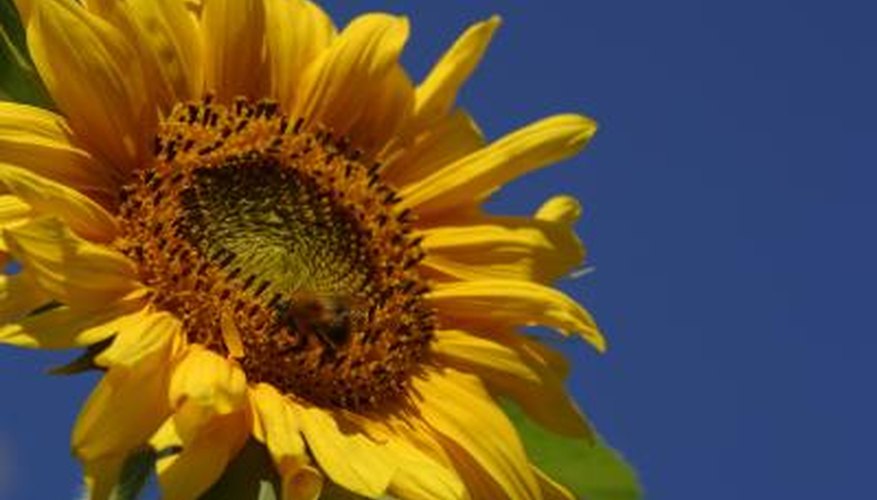Sunflowers come in an impressive range of varieties, from diminutive dwarf types suitable for planters to towering giants that provide hundreds of edible seeds. The annual sunflower blooms for a short period before dying, while the perennial sunflower returns each summer with fresh growth and new blooms. Caring for the sunflower once the blossoms fade depends on the variety you are growing.
Annual Sunflower Protection
Growing sunflowers as a seed crop has its own challenges. After annual sunflowers bloom, birds and animals often steal the seeds before they finish drying on the flower head. Protect the developing seeds as soon as the flowers begin to fade to stop animals from reaching them. Slipping an old nylon stocking over the flower head prevents birds from reaching the seeds but allows the seeds to dry properly on the plant. A paper bag placed over the flower head serves the same purpose. Secure the opening of the stocking or bag around the stem of the sunflower so any seeds that fall prematurely from the flower head aren't lost.
- Growing sunflowers as a seed crop has its own challenges.
- Slipping an old nylon stocking over the flower head prevents birds from reaching the seeds but allows the seeds to dry properly on the plant.
Seed Drying
Sunflower seeds do most of their drying on the plant. The flower heads are ready for harvesting once the back of the flower head changes from green to brown. Cut off the flower head, leaving it enclosed in the stocking or bag. Drying the seeds in a well-ventilated area for an additional week makes the seeds easier to separate from the flower head. When the seeds are dry, rub two flower heads together to dislodge the seeds. Roast or boil them for eating, or save the seeds in an airtight container until you are ready to use them.
- Sunflower seeds do most of their drying on the plant.
- When the seeds are dry, rub two flower heads together to dislodge the seeds.
Wildlife and Seeds
Growing seed-producing sunflowers also gives you access to a low-cost feed for your bird feeders. Leave the flowers on the stalks after the blossoms fade and allow the birds and animals to remove the seeds at will. Another option is to harvest the entire flower head after all the petals fall off. Leave a length of stem attached and hang the flower head on a pole or tree, creating a natural bird feeder.
- Growing seed-producing sunflowers also gives you access to a low-cost feed for your bird feeders.
- Leave a length of stem attached and hang the flower head on a pole or tree, creating a natural bird feeder.
Perennial Sunflowers
Perennial sunflowers don't produce the large edible seeds like most annual types, but they also provide a longer blooming period in summer. Cut off the old flower heads as soon as the petals begin to wilt in summer. Deadheading the old flowers stops seed production and encourages perennial sunflowers to send out a second set of flower buds. Continue to deadhead the sunflower plant until it stops sending up new blooms, usually in fall. Cut back the foliage after frost kills it back. The sunflower returns with new growth the following summer.
- Perennial sunflowers don't produce the large edible seeds like most annual types, but they also provide a longer blooming period in summer.
- Deadheading the old flowers stops seed production and encourages perennial sunflowers to send out a second set of flower buds.
